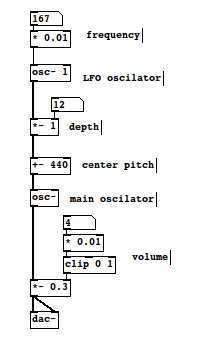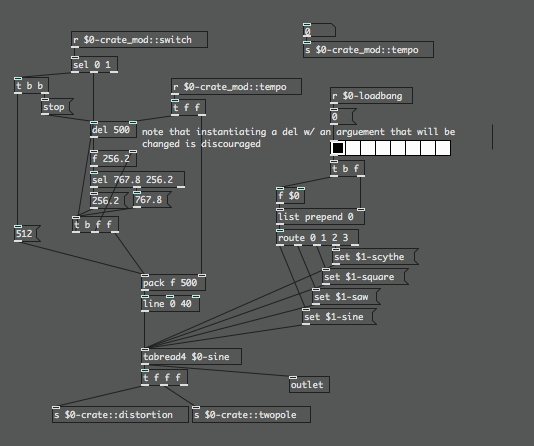Hi all,
PD beginner here, ive got an assignment to create a dub siren, really simple i thought, but i've got lost on how to create a pitch lfo? any thoughts would be appreciated, thanks!
Creating an LFO?
Hi all,
PD beginner here, ive got an assignment to create a dub siren, really simple i thought, but i've got lost on how to create a pitch lfo? any thoughts would be appreciated, thanks!
Using one oscillator to control the pitch of another achieves basic LFO. Of course you can use more complex waveforms for either the LFO or the signal, but the principle remains the same.

I'm curious -- does anyone on here have a favoured patching method for making a purely control message based LFO (i.e. without the use of a DSP oscillator as the LFO signal source)?
@NoDsp you could use 2 [line] objects
line-lfo.pd
I prefer to use [sin] with a counter for control level LFO.
any technology distinguishable from magic
is insufficiently advanced.
Thanks for both suggestions. I had been meaning to work out something like this for sending midi or other serial control. I'll have to use some method of range adjustment but I might be able to adapt these ideas.
Here is a control rate lfo I had in one of my patches.

I just used my oscillators' waveforms.
If you aren't actually storing some waveforms, then using a [sin] object would be the way to go. ...Basically just a choice between ram and cpu.
If you are switching the tabread between multiple arrays, then you need to control where the start and end points of the read will be.
In the pic above, the tabread goes from -1 to 1 and back by skipping the first and last quarter of the sine wave's cycle. Use two [sel ] and [f ] objects if you need to change those indices.
@Monetus Ah yes, thank you. I've actually got a large number of waveforms already loaded into multiple banks of array objects that I could put to use this way. I still have to work out those output range scaling issues, though.
Oops! Looks like something went wrong!